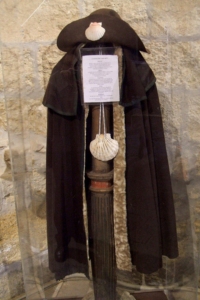The scallop shell, the symbol of the Camino de Santiago, may appear an unusual choice for a pilgrimage route. However, beneath its seemingly unassuming exterior lies the stuff legends are made of, but also a good deal of practicality, and clear liturgical connotations.
According to tradition, a storm scattered the remains of St. James as they were being taken from Jerusalem to Galicia –only to be found later, nestled amongst scallop shells. This story seemingly started the shell’s association with the saint. But there is a more prosaic, practical, down-to-earth rationale for this choice.

Scallop shells were plentiful along the Camino, Asturias and Galicia being coastal regions of the Iberian Peninsula. The shells, which were readily available, became a practical solution for pilgrims, serving as drinking cups, utensils, and even makeshift armor. This utility subsequently evolved into a badge of honor for pilgrims –a means of identifying themselves and their journey.
Symbol of unity, and not only
Of course, the shell’s symbolism transcends its utilitarian value. The radiating lines symbolize the various routes that pilgrims take, all of which converge on the same spiritual destination. This image also resonates with the universality of faith and the shared spiritual goal that unites pilgrims –many different lines, one shell. Additionally, the shell alludes to baptism and rebirth –the kind of transformation pilgrims go through while on their journey.
 Moreover, the shell’s association with St. James, a fisherman, has clear maritime connotations. The shell reflects the act of exploration and venturing into the unknown, which in turn mirrors the pilgrims’ spiritual quest. The shell becomes an emblem of the courage required for a journey of faith and self-discovery.
Moreover, the shell’s association with St. James, a fisherman, has clear maritime connotations. The shell reflects the act of exploration and venturing into the unknown, which in turn mirrors the pilgrims’ spiritual quest. The shell becomes an emblem of the courage required for a journey of faith and self-discovery.
Even today, the scallop shell continues to serve as a potent image. It is displayed in the Santiago de Compostela cathedral, appears on pilgrims’ passports, and is worn with pride by travelers. It is a reminder of the enduring legacy of St. James, and the transformative power of the Camino.





